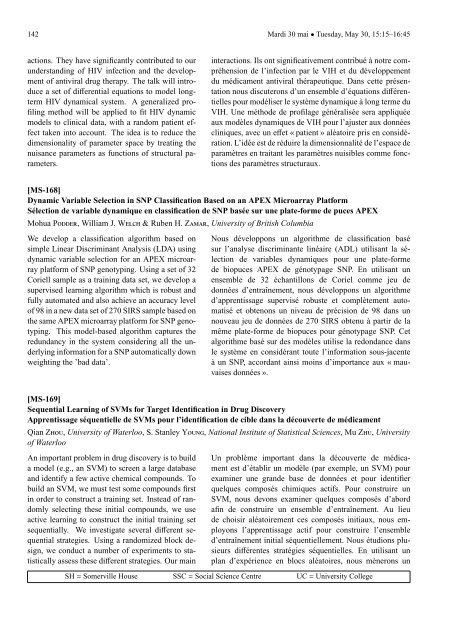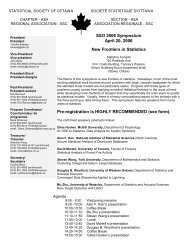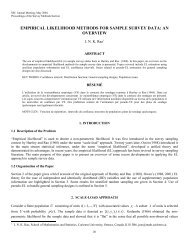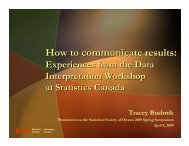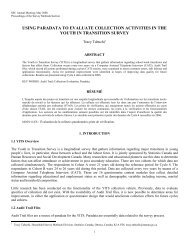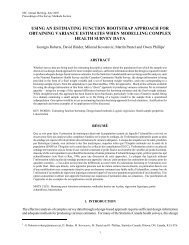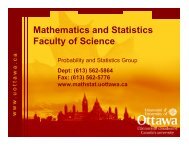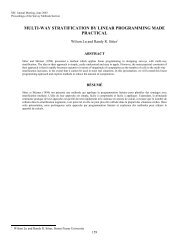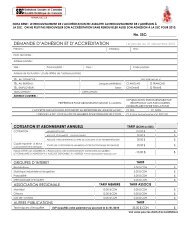Programme et résumés (pdf) - Société statistique du Canada
Programme et résumés (pdf) - Société statistique du Canada
Programme et résumés (pdf) - Société statistique du Canada
You also want an ePaper? Increase the reach of your titles
YUMPU automatically turns print PDFs into web optimized ePapers that Google loves.
142 Mardi 30 mai • Tuesday, May 30, 15:15–16:45interactions. Ils ont significativement contribué à notre com-préhension de l’infection par le VIH <strong>et</strong> <strong>du</strong> développement<strong>du</strong> médicament antiviral thérapeutique. Dans c<strong>et</strong>te présen-tation nous discuterons d’un ensemble d’équations différen-tielles pour modéliser le système dynamique à long terme <strong>du</strong>VIH. Une méthode de profilage généralisée sera appliquéeaux modèles dynamiques de VIH pour l’ajuster aux donnéescliniques, avec un eff<strong>et</strong> « patient » aléatoire pris en considé-ration. L’idée est de ré<strong>du</strong>ire la dimensionnalité de l’espace deparamètres en traitant les paramètres nuisibles comme fonc-tions des paramètres structuraux.actions. They have significantly contributed to ourunderstanding of HIV infection and the developmentof antiviral drug therapy. The talk will intro<strong>du</strong>cea s<strong>et</strong> of differential equations to model longtermHIV dynamical system. A generalized profilingm<strong>et</strong>hod will be applied to fit HIV dynamicmodels to clinical data, with a random patient effecttaken into account. The idea is to re<strong>du</strong>ce thedimensionality of param<strong>et</strong>er space by treating thenuisance param<strong>et</strong>ers as functions of structural param<strong>et</strong>ers.[MS-168]Dynamic Variable Selection in SNP Classification Based on an APEX Microarray PlatformSélection de variable dynamique en classification de SNP basée sur une plate-forme de puces APEXMohua PODDER, William J. WELCH & Ruben H. ZAMAR, University of British ColumbiaNous développons un algorithme de classification basésur l’analyse discriminante linéaire (ADL) utilisant la sé-lection de variables dynamiques pour une plate-formede biopuces APEX de génotypage SNP. En utilisant unensemble de 32 échantillons de Coriel comme jeu dedonnées d’entraînement, nous développons un algorithmed’apprentissage supervisé robuste <strong>et</strong> complètement auto-matisé <strong>et</strong> obtenons un niveau de précision de 98 dans unnouveau jeu de données de 270 SIRS obtenu à partir de lamême plate-forme de biopuces pour génotypage SNP. C<strong>et</strong>algorithme basé sur des modèles utilise la redondance dansle système en considérant toute l’information sous-jacenteà un SNP, accordant ainsi moins d’importance aux « mauvaisesdonnées ».We develop a classification algorithm based onsimple Linear Discriminant Analysis (LDA) usingdynamic variable selection for an APEX microarrayplatform of SNP genotyping. Using a s<strong>et</strong> of 32Coriell sample as a training data s<strong>et</strong>, we develop asupervised learning algorithm which is robust andfully automated and also achieve an accuracy levelof 98 in a new data s<strong>et</strong> of 270 SIRS sample based onthe same APEX microarray platform for SNP genotyping.This model-based algorithm captures there<strong>du</strong>ndancy in the system considering all the underlyinginformation for a SNP automatically downweighting the ’bad data’.[MS-169]Sequential Learning of SVMs for Targ<strong>et</strong> Identification in Drug DiscoveryApprentissage séquentielle de SVMs pour l’identification de cible dans la découverte de médicamentQian ZHOU, University of Waterloo, S. Stanley YOUNG, National Institute of Statistical Sciences, Mu ZHU, Universityof WaterlooAn important problem in drug discovery is to builda model (e.g., an SVM) to screen a large databaseUn problème important dans la découverte de médicamentest d’établir un modèle (par exemple, un SVM) pourand identify a few active chemical compounds. To examiner une grande base de données <strong>et</strong> pour identifierbuild an SVM, we must test some compounds first quelques composés chimiques actifs. Pour construire unin order to construct a training s<strong>et</strong>. Instead of ran- SVM, nous devons examiner quelques composés d’aborddomly selecting these initial compounds, we use afin de construire un ensemble d’entraînement. Au lieuactive learning to construct the initial training s<strong>et</strong> de choisir aléatoirement ces composés initiaux, nous emsequentially.We investigate several different se- ployons l’apprentissage actif pour construire l’ensemblequential strategies. Using a randomized block de- d’entraînement initial séquentiellement. Nous étudions plusign,we con<strong>du</strong>ct a number of experiments to sta- sieurs différentes stratégies séquentielles. En utilisant untistically assess these different strategies. Our main plan d’expérience en blocs aléatoires, nous mènerons unSH = Somerville House SSC = Social Science Centre UC = University College


